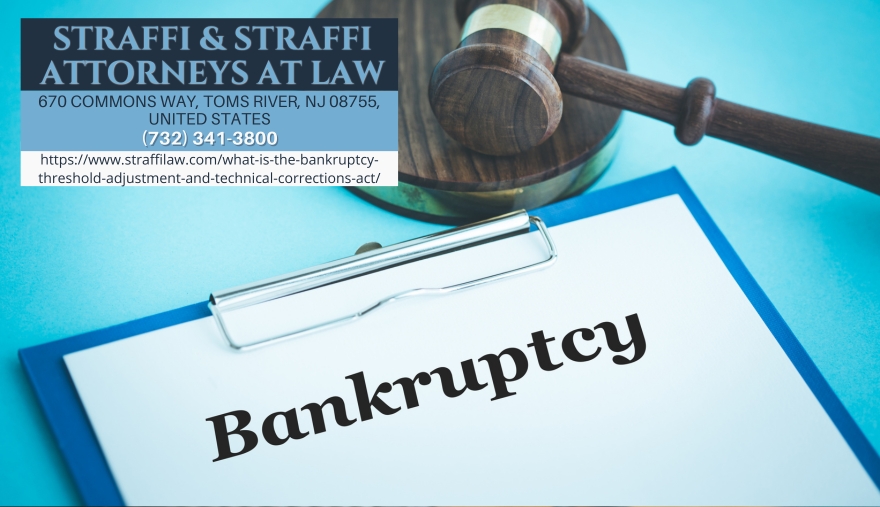Daniel Straffi (https://www.straffilaw.com/what-is-the-bankruptcy-threshold-adjustment-and-technical-corrections-act/), a New Jersey bankruptcy lawyer, is helping individuals and small businesses across the state understand the implications of the Bankruptcy Threshold Adjustment and Technical Corrections Act (BTATC Act). As economic uncertainties continue to impact debtors, the provisions and expiration of this law have brought new considerations for those seeking bankruptcy relief. The BTATC Act, enacted in 2022, introduced changes to the eligibility thresholds and legal definitions relevant to both Chapter 13 and Subchapter V bankruptcy filings. For many in New Jersey, these updates provided expanded access to relief at a time when economic conditions remained volatile.
With the assistance of a New Jersey bankruptcy lawyer, individuals and small businesses were able to navigate the temporarily increased debt limits. The BTATC Act raised the Chapter 13 debt threshold to $2.75 million, consolidating both secured and unsecured debts into a single limit. This change was particularly beneficial in a high-cost state like New Jersey, where debt levels often exceed federal limits due to elevated housing and business expenses. Daniel Straffi of Straffi & Straffi Attorneys at Law continues to interpret these changes for clients impacted by the expiration of these provisions on June 21, 2024.
A seasoned New Jersey bankruptcy lawyer, Daniel Straffi, highlights that the BTATC Act also adjusted the debt ceiling for small businesses under Subchapter V of Chapter 11. The law increased the threshold to $7.5 million, broadening eligibility for streamlined reorganization options. This was crucial in helping local businesses stay afloat without undergoing more drawn-out and costly bankruptcy proceedings. As Daniel Straffi explains, “The Act was designed to reflect current economic realities, temporarily removing barriers to relief for both individuals and businesses with significant financial burdens.” However, the return to pre-2022 thresholds may reduce these options for many in New Jersey.
Originally introduced to extend provisions of the CARES Act, the BTATC Act allowed both individuals and businesses to benefit from updated definitions and reduced procedural hurdles. For instance, it reinstated temporary changes to the definition of a “debtor” under Subchapter V, enabling retroactive relief claims for qualifying businesses. As part of its intent to clarify and correct inconsistencies in bankruptcy law, the Act modified language in the Bankruptcy Code to eliminate confusion, such as distinguishing between corporate affiliates and issuers under securities laws.
With the sunset clause now in effect, the previous debt limits have been reinstated: $465,275 for unsecured and $1,395,875 for secured debts under Chapter 13, and the original definitions under Subchapter V for businesses. While existing cases filed before June 22, 2024, remain valid under the higher limits, any new filings must comply with the restored, lower thresholds. Daniel Straffi underscores the importance of understanding how reclassification of debts during a case could impact ongoing eligibility and increase legal scrutiny.
These legislative shifts significantly affect individuals in New Jersey filing under Chapter 13. During the BTATC Act's active period, the single consolidated threshold allowed many with higher debt loads to qualify. With its expiration, fewer individuals may meet the separated requirements, particularly those burdened by both housing-related secured debts and high-cost unsecured obligations. The reversion of forms and local court procedures also adds a layer of administrative change that bankruptcy filers must now manage.
Small businesses in New Jersey are also confronting the implications of the reversion. Under the BTATC Act, simpler administrative processes and looser reporting obligations provided greater flexibility in navigating financial distress. Now, those same businesses must adhere to older, more demanding standards. Daniel Straffi notes that businesses close to the debt limits face the risk of being ineligible for Subchapter V and having to pursue full Chapter 11 reorganizations, which are typically longer and more resource-intensive.
While the BTATC Act offered significant advantages in its temporary form, its expiration marks a shift back to a stricter bankruptcy framework. These changes underscore the need for legal guidance when planning or pursuing bankruptcy relief. From altered definitions to modified procedural requirements, the post-BTATC environment demands careful consideration.
For residents and business owners in New Jersey, understanding these legal changes is essential in determining the best path forward. The support of a dedicated New Jersey bankruptcy lawyer like Daniel Straffi can help individuals and entities make well-informed decisions in a post-BTATC legal landscape. Straffi & Straffi Attorneys at Law continues to assist clients in reviewing their eligibility, understanding evolving laws, and selecting bankruptcy options that align with current financial realities.
To stay prepared, reviewing debt levels and timing filings accordingly can protect eligibility under applicable rules. Whether facing financial strain due to personal hardship or business downturn, timely legal support remains a critical resource for navigating debt relief effectively.
About Straffi & Straffi Attorneys at Law:
Straffi & Straffi Attorneys at Law is a New Jersey-based legal practice focused on helping individuals and businesses manage debt through strategic use of bankruptcy laws. Led by Daniel Straffi, the firm advises clients on navigating evolving legal standards and provides guidance across various chapters of the Bankruptcy Code. With a commitment to clarity and client understanding, the firm helps those facing financial distress identify effective legal solutions for recovery.
Embeds:
Youtube Video: https://www.youtube.com/watch?v=jS56_31fAbg
GMB: https://www.google.com/maps?cid=18340758732161592314
Email and website
Email: familyclient@straffilaw.com
Website: https://www.straffilaw.com/
Media Contact
Company Name: Straffi & Straffi Attorneys at Law
Contact Person: Daniel Straffi
Email: Send Email
Phone: (732) 341-3800
Address:670 Commons Way
City: Toms River
State: New Jersey 08755
Country: United States
Website: https://www.straffilaw.com/


